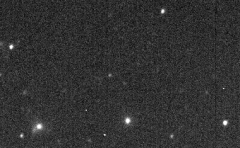Erriapus (księżyc)
 | |
| Planeta | |
|---|---|
| Odkrywca | John J. Kavelaars, Brett J. Gladman i inni[1] |
| Data odkrycia | 23 września 2000[1] |
| Tymczasowe oznaczenie | S/2000 S 10 |
| Charakterystyka orbity | |
| Półoś wielka | 17 602 000 km[2] |
| Mimośród | 0,4722[2] |
| Okres obiegu | 871,14 d[2] |
| Nachylenie do ekliptyki | 34,481°[2] |
| Długość węzła wstępującego | 150,985°[2] |
| Argument perycentrum | 282,522°[2] |
| Anomalia średnia | 294,829°[2] |
| Własności fizyczne | |
| Średnica równikowa | 10 km[3] |
| Średnia gęstość | 2,3 g/cm³[3] |
| Okres obrotu wokół własnej osi | |
| Albedo | 0,06[3] |
| Jasność obserwowana (z Ziemi) | |
Erriapus (Saturn XXVIII) – mały księżyc Saturna, odkryty pod koniec września 2000 roku przez Johna Kavelaarsa i Bretta Gladmana z zespołem za pomocą 3,6-metrowego Teleskopu Kanadyjsko-Francusko-Hawajskiego na Mauna Kea.
Nazwa
W sierpniu 2003 roku ogłoszono nazwę księżyca jako Erriapo (w celowniku). W 2007 roku nazwa ta została poprawiona na Erriapus (w mianowniku)[5]. Nazwa pochodzi od imienia giganta z mitologii galijskiej[1].
Orbita
Erriapus należy do grupy galijskiej nieregularnych zewnętrznych księżyców planety[1]. Podobieństwo orbit i lekko czerwonawa barwa powierzchni może wskazywać, że satelity z tej grupy mają wspólne pochodzenie, lub że jest on fragmentem Albioriksa[1].
Zobacz też
- Chronologiczny wykaz odkryć planet, planet karłowatych i ich księżyców w Układzie Słonecznym
- Księżyce Saturna – zestawienie podstawowych danych
Przypisy
- ↑ a b c d e Erriapus. [w:] Solar System Exploration [on-line]. NASA. [dostęp 2018-12-28]. (ang.).
- ↑ a b c d e f g Planetary Satellite Mean Orbital Parameters. Jet Propulsion Laboratory, 2013-08-23. [dostęp 2016-02-25]. (ang.).
- ↑ a b c d Planetary Satellite Physical Parameters. Jet Propulsion Laboratory, 2015-02-19. [dostęp 2016-02-25]. (ang.).
- ↑ T. Denk, S. Mottola: Saturn's Irregular Moon Ymir. [w:] DPS meeting #44 [on-line]. American Astronomical Society, październik 2012. [dostęp 2016-02-09]. (ang.).
- ↑ Spelling of Saturn XXVIII. [w:] Astrogeology Science Center [on-line]. 2007-12-17. [dostęp 2016-02-09]. (ang.).
Linki zewnętrzne
- Erriapus. [w:] Solar System Exploration [on-line]. NASA. (ang.).
Media użyte na tej stronie
This is a revised version of Solar_System_XXIX.png.
Saturn Cassini-Huygens (NASA)
Instrument: Imaging Science Subsystem - Narrow Angle
Saturn's peaceful beauty invites the Cassini spacecraft for a closer look in this natural color view, taken during the spacecraft's approach to the planet. By this point in the approach sequence, Saturn was large enough that two narrow angle camera images were required to capture an end-to-end view of the planet, its delicate rings and several of its icy moons. The composite is made entire from these two images.
Moons visible in this mosaic: Epimetheus (116 kilometers, 72 miles across), Pandora (84 kilometers, 52 miles across) and Mimas (398 kilometers, 247 miles across) at left of Saturn; Prometheus (102 kilometers, 63 miles across), Janus (181 kilometers, 113 miles across) and Enceladus (499 kilometers, 310 miles across) at right of Saturn.
The images were taken on May 7, 2004 from a distance of 28.2 million kilometers (17.6 million miles) from Saturn. The image scale is 169 kilometers (105 miles) per pixel. Moons in the image have been brightened for visibility.
The Cassini-Huygens mission is a cooperative project of NASA, the European Space Agency and the Italian Space Agency. The Jet Propulsion Laboratory, a division of the California Institute of Technology in Pasadena, manages the Cassini-Huygens mission for NASA's Office of Space Science, Washington, D.C. The Cassini orbiter and its two onboard cameras, were designed, developed and assembled at JPL. The imaging team is based at the Space Science Institute, Boulder, Colo.
For more information, about the Cassini-Huygens mission visit, http://saturn.jpl.nasa.gov and the Cassini imaging team home page, http://ciclops.org.Autor: Brett Gladman/Canadian Astronomy Data Centre, Licencja: CC BY-SA 4.0
Animation of three discovery images of Saturn's irregular moon Erriapus (S/2000 S 10), taken by the 3.6-meter Canada-France-Hawaii Telescope (CFHT) on 23 September 2000. Each image was taken approximately 90 minutes apart, showing the moon's motion relative to the background stars and galaxies. The raw image datasets used are 550468p, 550478p, and 550490p. For comparison, the star field in these images can be viewed at the CDS's Aladin star atlas.


